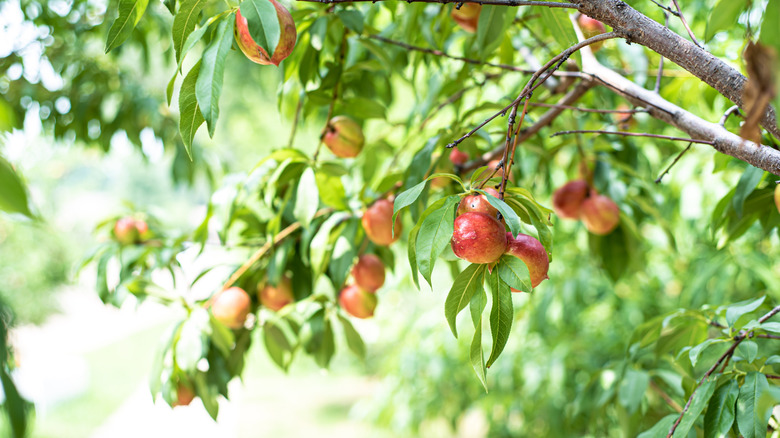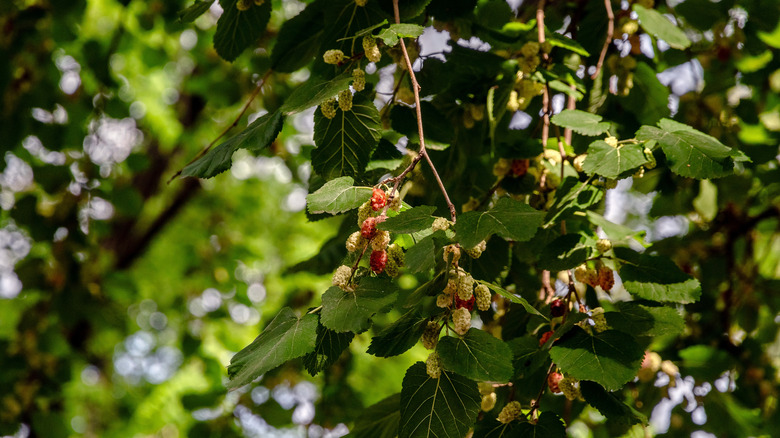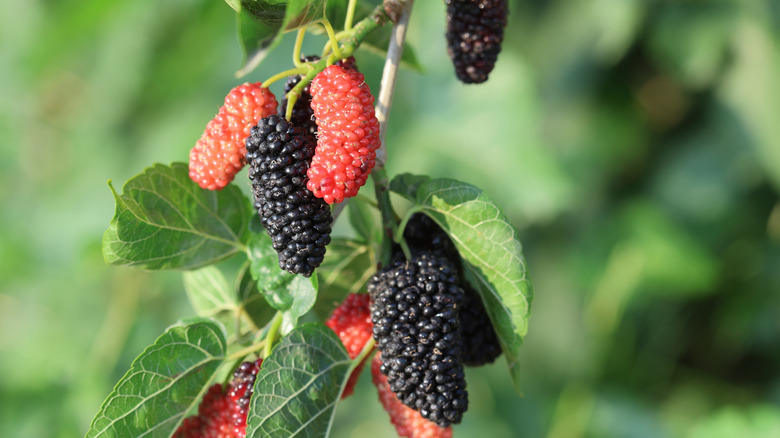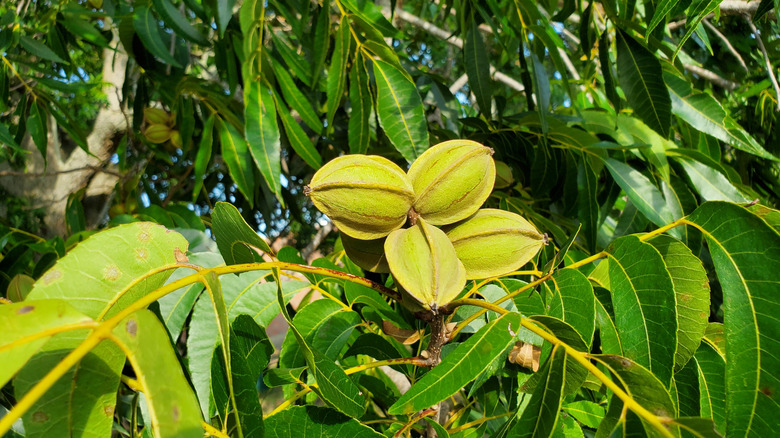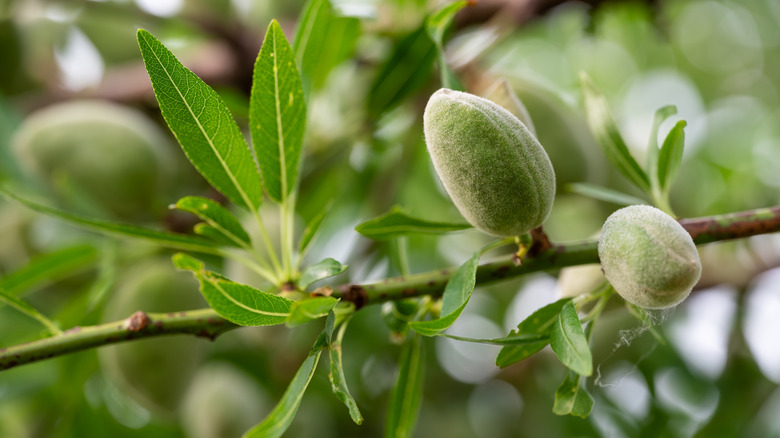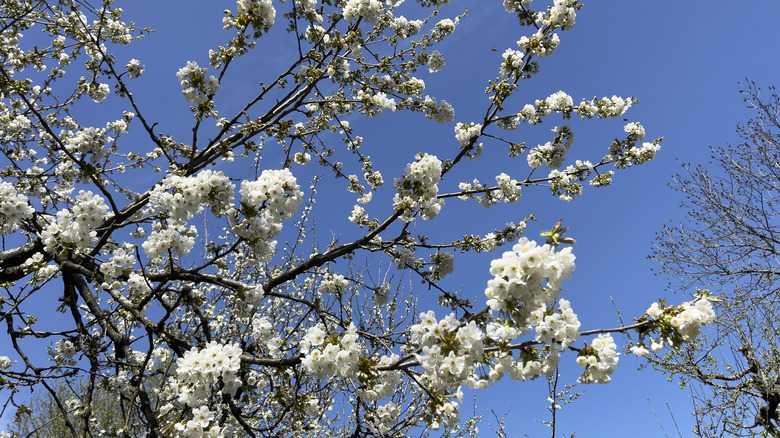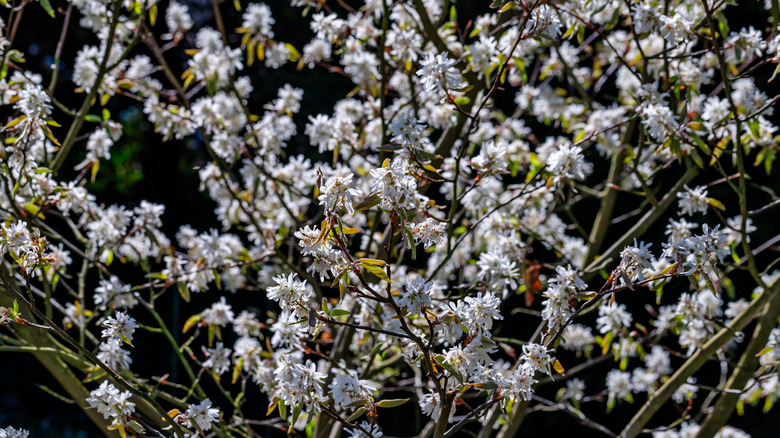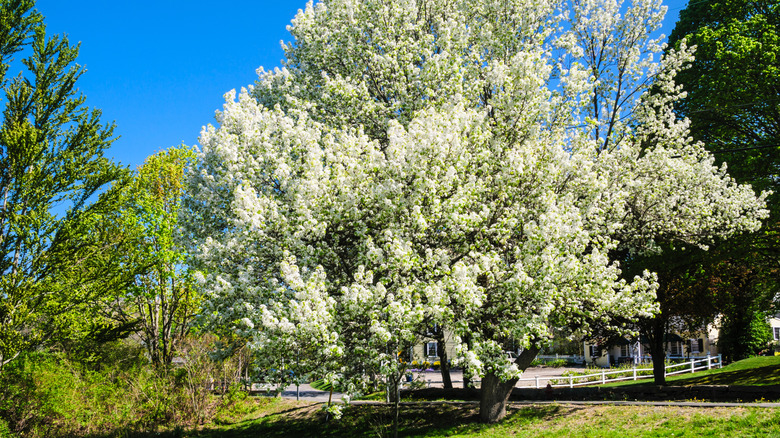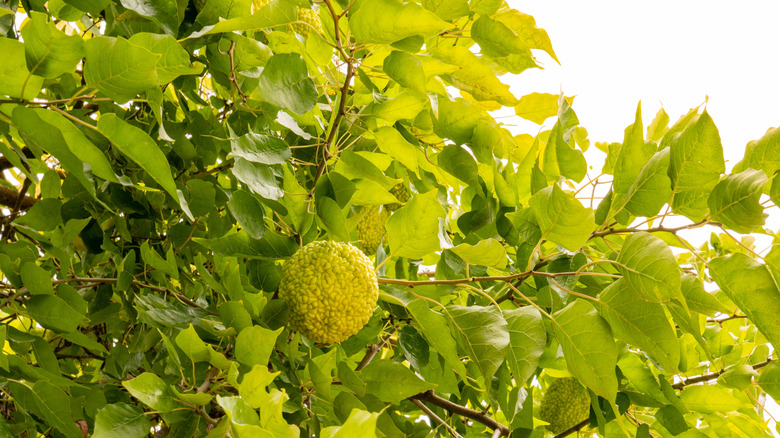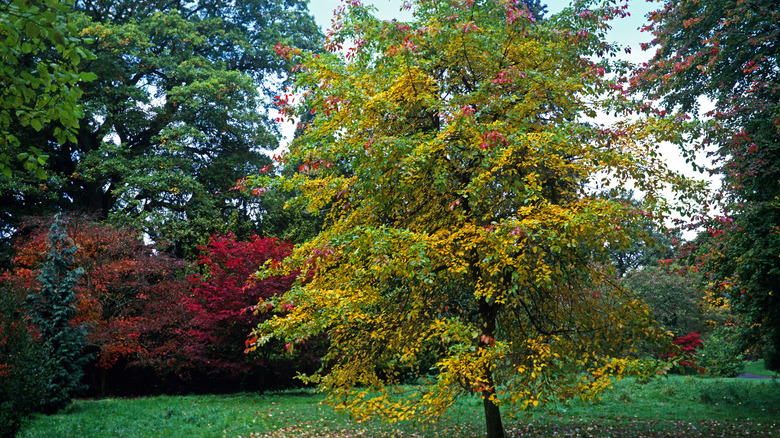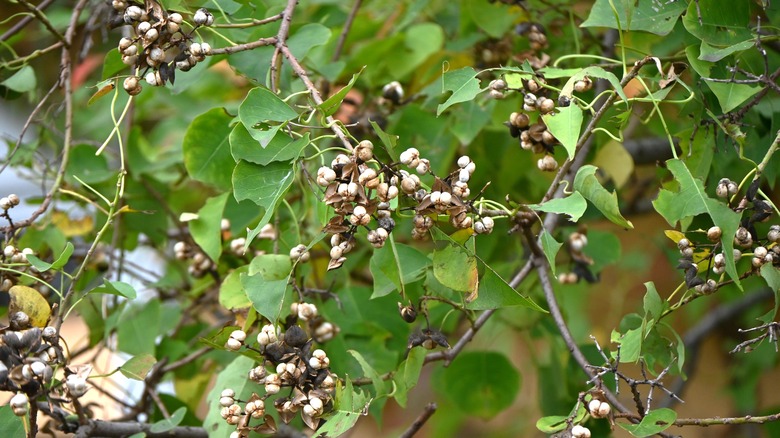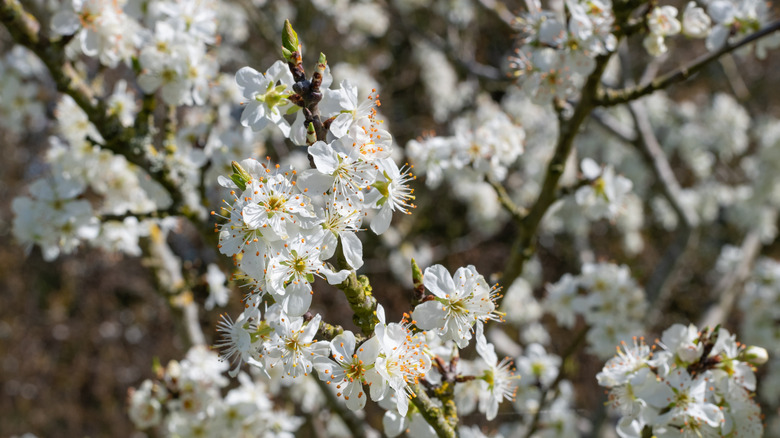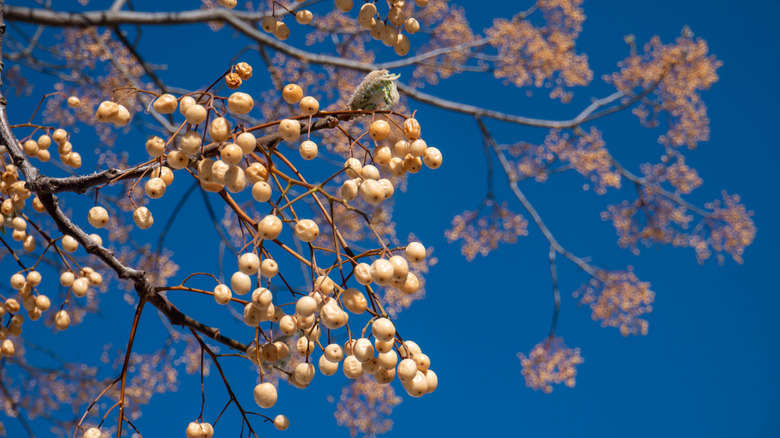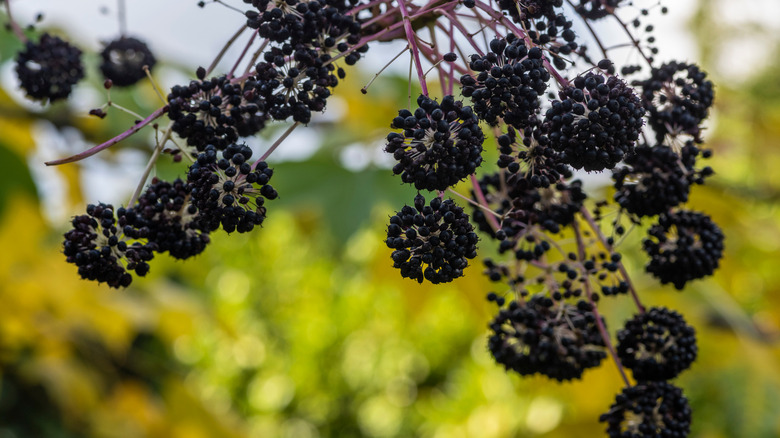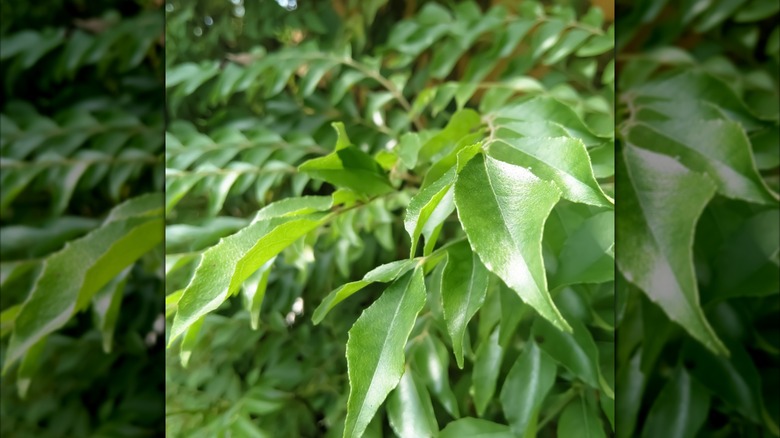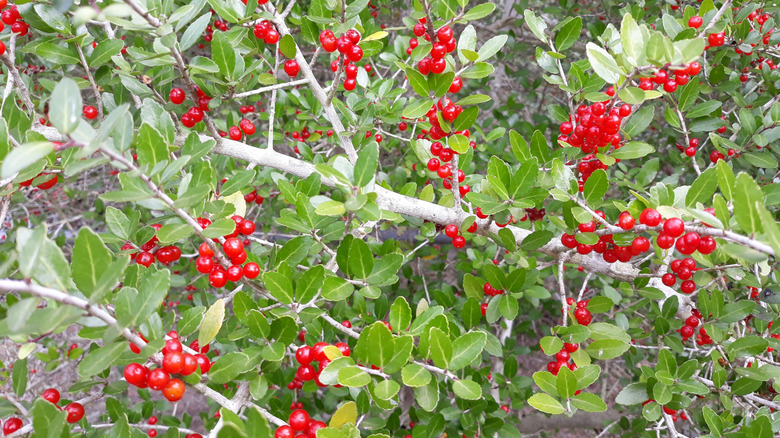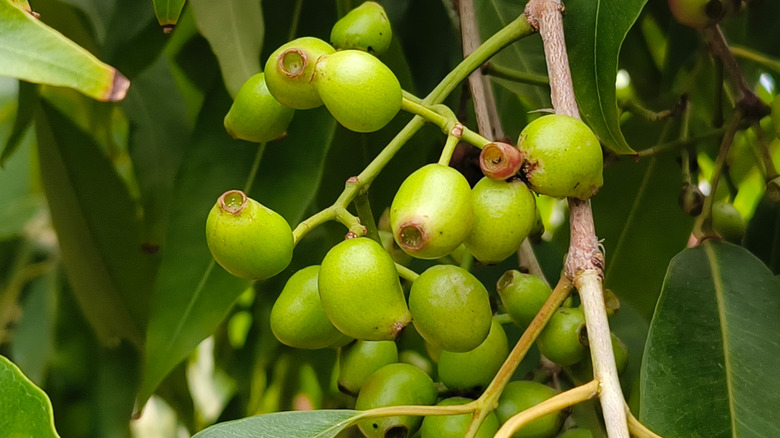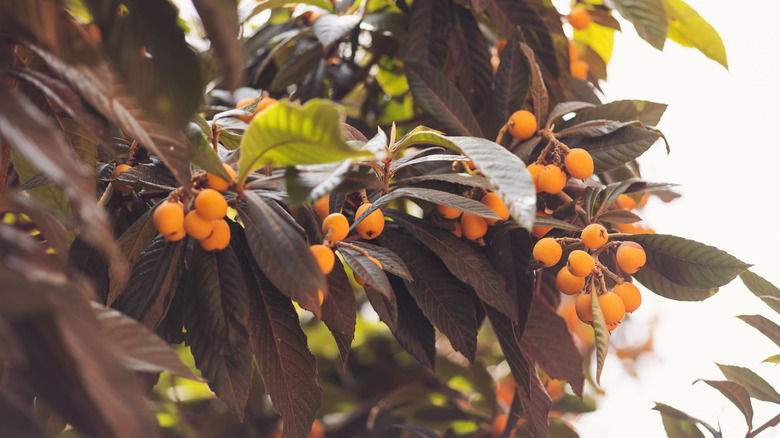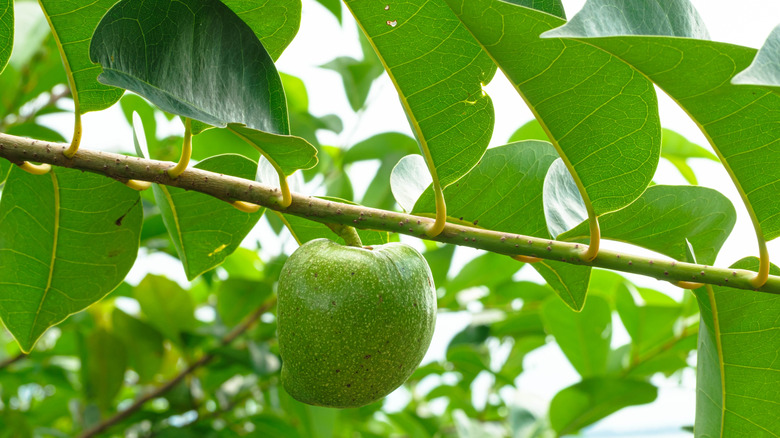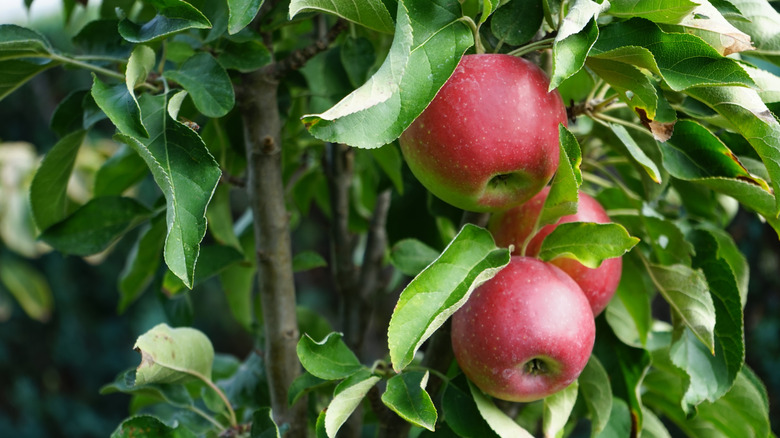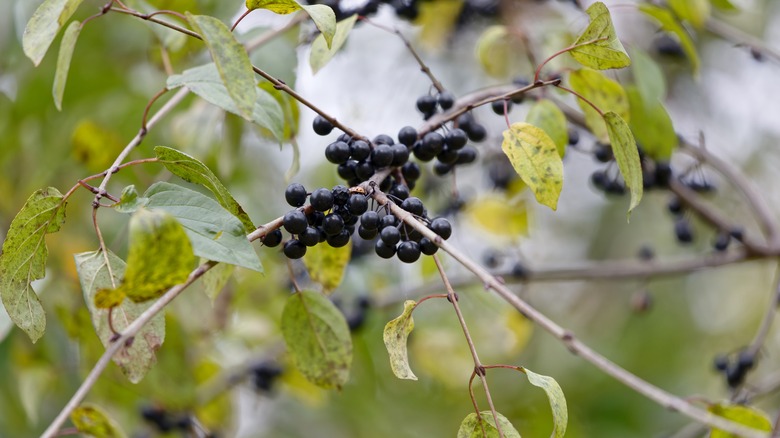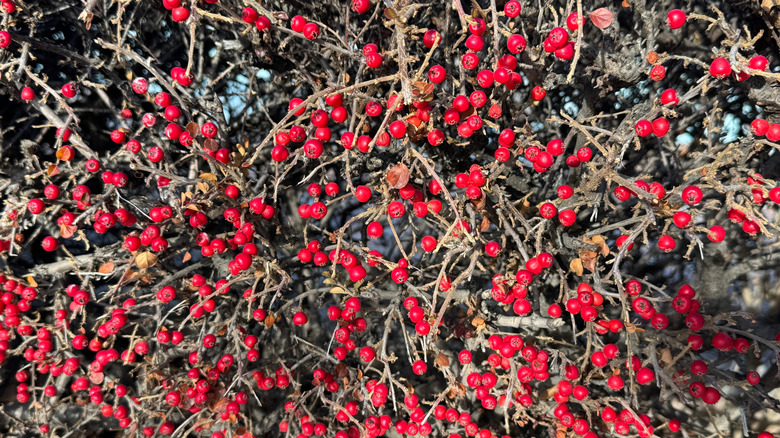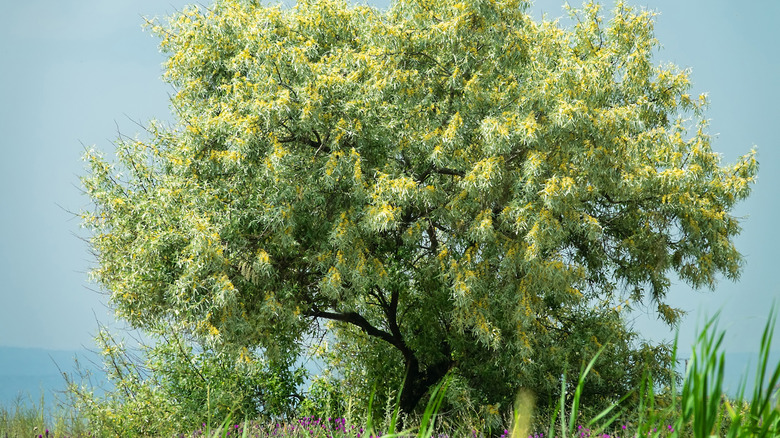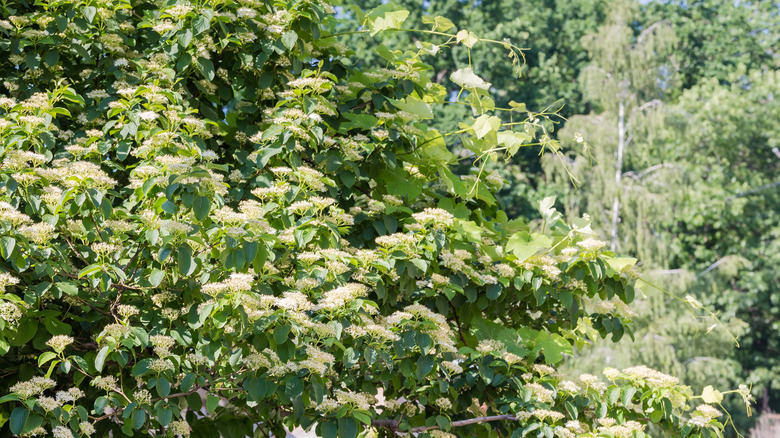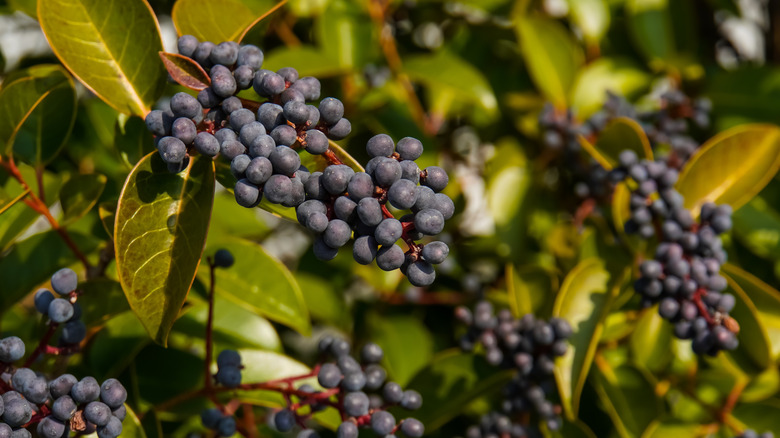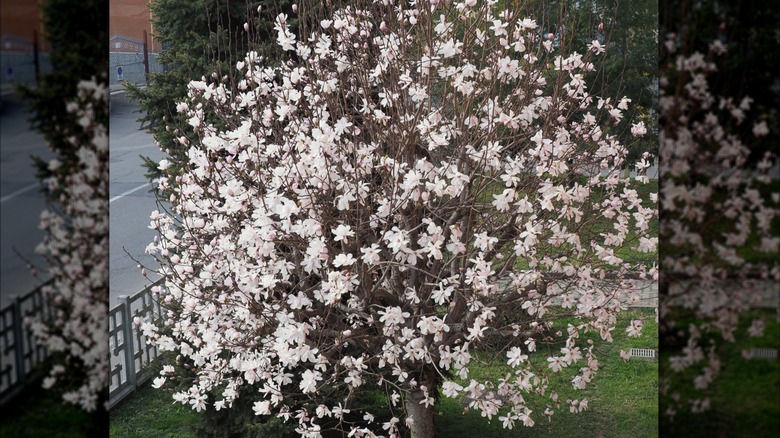13 Fruit Trees To Avoid Growing In Your Yard (& Better Alternatives)
There's a subliminal charm to watching birds stuffing their beaks with berries. Unless, of course, it's the dead of the winter, and they're growing inebriated after overindulging in fermented fruit — that's the time to call wildlife rehabbers. Apart from that, though, it's equally lovely to join in on the fun, plucking off drupes from the fruit trees decking your yard. Or, simply basking in their ornate beauty when they're excessively acerbic for you. Alas, not all fruit-bearing trees deserve a spot in your home landscape for varying reasons. To elaborate, invasive trees like Bradford pear, sweet cherry, and autumn olives should be avoided at all costs to safeguard the native ecosystem.
Similarly, Chinese tallow and Chinaberry should be off your planting list, unless you wish to risk messing up the soil composition. Fruit trees like Java plum and white mulberry make poor planting choices because they create massive leaf and fruit litter, entailing significant cleanup. Certain trees may be inappropriate because they grow too large, like Osage-orange. Others, like pecan trees, may need multiple pollinating partners so they may bear fruits in the first place. So, to help you and the wildlife visiting your yard truly reap the benefits of your labor, below we list the fruit trees to avoid growing — along with some excellent alternatives.
Don't plant: White mulberry
White mulberry (Morus alba) trees' purplish-black berries offer the perfect trifecta of ornamental beauty, palatability (both raw and in jams), and wildlife value (birds relish its sweetness). Yet, you must avoid planting these fast-growing trees for three reasons. Firstly, white mulberry is invasive in a number of states. Apart from displacing native species, this tree also blasts its pollen far off into the distance and cross-pollinate with, or spread a fatal root disease to the native red mulberry trees. They also entail heavy maintenance because their fruits leave unsightly stains.
Do plant: Red mulberry
Instead of white mulberry, better alternatives include red mulberry (Morus rubra) trees or its hybridized cultivars, like 'Illinois Everbearing' or 'Silk Hope.' They similarly produce highly saccharine red berries that can be plucked off the tree, assuming mockingbirds, catbirds, and rodents have spared some. Moreover, their fruits aren't available commercially, given their brittle fruit skins and short shelf life. So, growing them in your backyard is the only way to enjoy the juicy sweetness, though staining will present problems. Red mulberry is native to the eastern U.S. and Canada and robust in USDA zones 4 through 9.
Don't plant: Pecan trees
Pecan trees (Carya illinoinensis) are well suited for building a tree house and are popular because of their delicious nuts (which are, in fact, dry fruits). However, growing them in your backyard could be a waste of your time, as their production and quality are highly unreliable. This problem is especially acute in the tree's northern adaptive ranges, due to the short growth season. Worse yet, pecan trees require at least three different cultivars to stimulate fruit production. Considering a standalone tree extends 70 feet across and the production dynamics poor, these trees don't work for most residential landscapes.
Do plant: Almond trees
Instead of pecans, elect to grow the smaller almond trees. Opt for Prunus dulcis, not the flowering variety, Prunus triloba. They max out at 15 feet top and across and produce savory nuts in their stone fruits. Like pecan, they don't self-fruit but make do with another cultivar to keep their fruits coming. Curiously, since they're actually related to peaches, almonds are known to hybridize with them, provided they're flowering at the same time. 'Nonpareil' and 'Texas' offer the best flavor, while 'All-in-one' can self-fertilize. Almond trees are winter hardy in zones 7 through 9.
Don't plant: Sweet cherry
At a glance, sweet cherry (Prunus avium) trees have a lot to offer: gorgeous blooms in spring, grooved foliage that supports swallowtails, and irresistible red drupes that make summers so much better (even for birds). However, it has little regard for boundaries and is considered invasive in some states, including Oregon and Virginia. Its high proclivity to myriad pests and diseases, such as scales, sawflies, cherry leaf spot, brown rot, canker, and crown gall, makes it a high-maintenance tree. Also, it's unsafe around furry friends who might gorge on its pits.
Do plant: Downy serviceberry
Downy serviceberry (Amelanchier arborea) is the native berried tree you'll want to grow for all of its benefits. Like sweet cherry, it swathes the spring garden with white blossoms, attracting pollinators. To delight gardeners and birds, it bears a massive crop of edible, reddish-purple berries in late summer; these are a sweeter version of blueberries. It's a slow grower, measuring taller than it is wide, maxing out at 25 feet at maturity. Downy serviceberry sprouts root suckers, which you must remove intermittently to keep it contained — it'll look bushy otherwise. It's hardy in zones 4 through 9.
Don't plant: 'Bradford' pear
Hybridized from Chinese native Callery pear and the common pear trees, 'Bradford' pear (Pyrus calleryana 'Bradford') took off in the 1900s for its tolerance to environmental stressors and diseases. Unfortunately, it readily escapes from its confines and cross-fertilizes with the other pear trees, producing fertile fruit (and seeds). It also displaces other native trees in the wild. For this reason, it's unlawful to plant this cultivar in states where it's considered invasive. Besides, it's weak-limbed and prone to breakage and branch dieback, which makes it hazardous in residential landscapes.
Do plant: Wild plum
In place of the Bradford pear, plant wild plum (Prunus americana) instead. It's a single-trunked, drought-resistant tree native to the central and east U.S., mostly planted for its ornamental and wildlife value. It brightens summers for quail, turkeys, and scores of songbirds with its purplish-red plums. While you could snag a couple of plums off the branches, they don't taste great raw and are best used in preserved. Since the 20-foot-tall tree is fire-resistant, you can plant it in your home's defensible zone. It's hardy in zones 4 to 9.
Don't plant: Osage-orange
Unless sited on your property line as a security hedge (those thorns are dreadful), growing Osage-orange (Maclura pomifera) is one expensive way to stink up your landscape. Around fall, its golden fruits ripen and roll down the limbs, messing up the floor underneath with their malodorous, skin-irritating latex. Moreover, the fruits aren't edible to most animals, save for a few small mammals. Another reason to avoid these trees is that they can overwhelm a small backyard with their 70-foot tall (and similarly wide) physique.
Do plant: Black gum
Also known as black tupelo, black gum (Nyssa sylvatica) is an ornamental tree you can plant in Osage-orange's stead. It adds a lovely orangish-yellow fall color (or red, depending on the cultivar). Moreover, it brings fall birds to your yard and garden, who fatten up on the green fruits before migrating south. You can steal a bite or two, too, if you've got the smack for sour fruits. Since its canopy doesn't grow wider than 35 feet, it's appropriate in small gardens in zones 4 to 9. Plant a male pollinator alongside for good fruiting.
Don't plant: Chinese tallow
Although birds adore this tree, Chinese tallow (Triadica sebifera) comes with some major problems, such as being invasive in several U.S. states. Alternatively called the popcorn tree for its trifecta of white seeds, Chinese tallow has been wreaking havoc on native plants as it easily crowds them out through its profuse suckering and seeding. This is also why it's so difficult to eliminate from residential landscapes, even with chemical control. When its leaf litter is allowed to decompose on the ground, it alters the soil composition, which on runoff further modifies aquatic systems and harms wildlife, including frogs.
Do plant: Chickasaw plum
Chickasaw plum (Prunus angustifolia) is one of the better alternatives to grow instead of the invasive Chinese tallow tree in zones 5 through 9. It punctuates the winter-spring transition with gorgeous white blooms, drawing the attention of pollinators. Around summer, it sets red fruits that are readily nibbled on by birds and mammals, while the gardeners wait for them to ripen before relishing their tartness. Chickasaw plums usually grow 20 feet tall, but you can prune them to a shorter height. However, be prepared to regularly pull out their root suckers unless you don't mind them naturalizing.
Don't plant: Chinaberry
Chinaberry (Melia azedarach) may look like the perfect fit for your yard, blanketed in its lilac blooms and chocolate-y aroma. But growing these trees to attract hummingbirds is a big mistake, as is growing them for their wrinkled fruits. Since it quickly acclimates to most environments, piggybacking on its fast growth rates, it establishes dense colonies, crowding out native vegetation. Moreover, it lacks biological enemies and releases allelopathic chemicals, harming nearby plants. That's why it's deemed invasive across most southern states and must be removed if already established in yards.
Do plant: Hercules' club
Hercules' club (Aralia spinosa), or devil's walking stick, is amongst the most novel and beautiful alternatives to invasive chinaberry trees that'll make your yard stand out. During fall, its pink stalks burst out masses of purplish-black fruits that myriad birds delight in. It's tolerant of most soil conditions, herbivory, drought, fire, and urban pollution, and is hardy in zones 4 through 9. Although the tree is quite narrow at 10 feet, it's unsuitable for small sites. That's because it fires out multiple suckers, requiring regular removal. Wear thick gloves before handling to avoid contact dermatitis and spines.
Don't plant: Autumn olives
Despite its numerous benefits, such as nitrogen fixation, edible fruits, ability to block wind, and serving as a wildlife cover, autumn olive (Elaeagnus umbellate) is another fruit tree you must steer clear of. Since its fruits are so well-liked by birds, it manages to spread and naturalize in disturbed and infertile sites when the feathered creatures disperse their seeds. As a result, it outcompetes the native plants and is considered invasive or noxious in many states. Moreover, its stems are heavily decked out in thorns, which makes pruning difficult.
Do plant: Yaupon holly
To maintain your garden's wildlife value as well as enjoy a wind barrier, grow yaupon holly (Ilex vomitoria) — the female plant, in particular. These evergreen trees render year-round interest with spring-blooming, butterfly-friendly white flowers and sweet-tasting red, yellow, or orange berries. Fortunately, these fruits persist through winter to the utter joy of famished birds and small rodents who might even harbor in its foliage. However, you'll need to grow a male pollinator, too, to maintain good cropping. In zones 7 through 9, these deer-resistant, fast-growing trees will thrive in damp soil. Watch for and remove volunteers regularly.
Don't plant: Java plum
Java plum (Syzygium cumini) has seeded berries that have quite the following in culinary circles, while birds patiently wait for the fruits to turn black before gorging on them. However, the ensuing aggressive seed dispersal has turned Java plums into a category I invasive in Florida. Java plum can also tower 100 feet high — quickly at that — and block light for the abutting indigenous shrubbery. Moreover, its fruit litter can worsen the fly infestation in your yard because it deteriorates and ferments swiftly.
Do plant: Loquat
Hailing from Asia, loquat, or Japanese plum (Eriobotrya japonica), is an easy-to-grow, non-invasive, broadleaf evergreen fruit tree hardy in zones 8 through 11. By blooming nectar-rich white blossoms, it lures in hummingbirds throughout fall and winter. It also produces a mammoth harvest of edible orange or yellow-fleshed plums (depending on the cultivar) by spring. While loquats are drought-tolerant, watering them thoroughly improves the harvest. Pests aren't a problem usually, but if you spot ants or aphids, watch for fire blight as they may vector this disease. Site the tree away from high-traffic areas to avoid stepping on dropped fruits.
Don't plant: Pond apple
While the pond apple (Annona glabra) has a rich history of supporting Native Americans with its brown-spotted, yellow-fleshed edible fruits, you must avoid growing it as a fruit tree. The reason? A single apple has over 100 seeds that, despite looking similar to pumpkin seeds, lack its palatability and are toxic to humans. However, if you're saddled with a bog garden where most plants struggle or experience harsh salt sprays, pond apples may be grown feed and provide shelter to birds and squirrels.
Do plant: Columnar apples
If you're looking for fruits to grow on a balcony or patio since you don't have space for a garden, explore the world of columnar apples, also called spire and urban apples. They thrive in zones 4 to 9, and you can grow them in pots that are at least 20 inches wide and deep when given full sun exposure, a good potting mix, and winter protection. They max out at 8 feet when mature and must be spaced at least 3 feet wide when grown in the ground. Look for disease-resistant varieties to minimize chemical control.
Don't plant: European buckthorn
Imported from Eurasia as an ornamental, European Buckthorn (Rhamnus cathartica) has altered the native ecosystems, especially maple and oak forests, turning invasive in the U.S. Northeast and parts of the Midwest. Deer and birds rely on their purple berries for winter food, and this only powers the trees' spread. Buckthorns pack into dense thickets with a mickle of spines to boot, outmaneuvering the natural vegetation. These fruit trees are difficult to eliminate, since neither burning nor shearing is effective. Another reason to avoid growing European buckthorns is that they harbor the overwintering larvae of soybean aphids.
Do plant: Winterberry holly
Hardy in zones 3 through 9, winterberry holly (Ilex verticillata) might be a good fit for small yards, as it caps out at 15 feet and measures similarly across. Though it loses its leaves by winter, the branches are never bare as they're festooned by vivid red berries. This brings Christmas cheer to over 40 bird species, including cedar waxwings. However, to enjoy the fruits, you must team the female plants with a male pollinator — or hope your neighbor has one in a 50-foot proximity.
Don't plant: Russian olive
Russian olive (Elaeagnus angustifolia) trees gained attention for their nitrogen fixation capabilities and high resistance to salt, deer browsing, and drought. But because birds relish their silver fruits (that could pass off for olives until they turn red in time for the fall's arrival) and scatter their seeds, they've become noxious weeds or downright invasive in the west and northeast regions. Russian olives are particularly notorious for pushing out native cottonwoods and modifying riparian ecosystems. Also, as they establish deep root systems and sucker profusely, they're hard to eliminate.
Do plant: Pagoda dogwood
For multi-season interest, plant alternate-leaf or pagoda dogwood (Cornus alternifolia). It explodes in milky white blooms around spring, enticing a legion of pollinators, including bees, butterflies, and moths. Summer onwards, it sets green drupes that eventually turn white and then black, gaining a chokehold on birds, chipmunks, squirrels, and rabbits. However, most gardeners find their fruits disagreeable. Dogwoods enjoy cool summers, and don't grow outside of zones 3 through 7. Keep them sheltered and mulched, lest they suffer ice damage. While they resist browsing, pagoda dogwood trees are vulnerable to several diseases, like cankers, blight, and mildew.
Don't plant: Japanese privet
When not severely sheared into a bushy mound, Japanese privet (Ligustrum japonicum) behaves as a small fruit tree. Although birds are drawn to its bluish-black berries, especially in winter when other food sources are scarce, it's best to keep away from this silver-stemmed tree. That's because it tends to escape from its bounds and fights for resources with native plants — winning in most cases. Besides, it's difficult to remove once established. It features on the invasive lists of several U.S. states.
Do plant: Sweet bay magnolia
Indigenous to the southeast U.S., sweet bay Magnolia (Magnolia virginiana) is a better replacement for Japanese privet. It allures birds with the red seeds threading out of its conical fruits, while the evergreen foliage provides critical winter cover after it's done hosting swallowtails. Besides, magnolia trees handle droughts, urban pollution, salt, and wet soils extremely well in zones 5 through 10. Although they typically max out at 35 feet, they may grow higher down south, so stick to dwarf cultivars. Mulch protection is essential for overwintering trees in zones 5 and 6.
